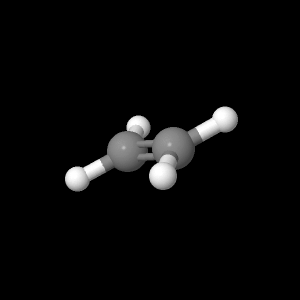Valence
Bond Model of the Double Bond
(ethylene as the example)
At right is a 3-D version of the Lewis structure of the ethylene
molecule. You may rotate the molecule yourself by holding the
mouse button down while dragging it around within the image
frame. Dark grey spheres represent C atoms and light grey
(white) spheres represent hydrogen atoms. Single bonds are
represented as single sticks and double bonds as a pair of
sticks. To return to this view at any time click on the button
below:
Each carbon atom is surrounded by three "groups" as specified in the
VSEPR
model for molecular shapes. An atom surrounded by three
groups will be sp
2
hybridized to get orbitals pointing in the correct directions to
make bonds at 120 degrees from each other. Click the button below to
show these hybrid orbitals on one
C.
Single bonds (σ-bonds) are made by overlapping hybrid orbitals pointed
along the
bonds. The σ-bond that is part of the double bond in ethylene
is made by the overlapping sp
2 hybrids on the neighboring C
atoms. Click on the button below to show the hybrid orbitals on the
other C atom and the overlap forming the σ-bond.
The bonds to the H atoms are made by overlapping the remaining hybrid
orbitals with the H 1s orbitals. Click on the button below to add
the H 1s orbitals.
This represents the σ-bonding framework of the ethylene molecule.
π-bonds are made by the side-on overlap of p orbitals on neighboring
atoms. To add the two p orbitals that are left over on the
carbons from the formation of the sp
2 hybrid orbitals click
on the
button below.
The yellow orbitals are the p orbitals.
To show how the two p orbitals combine to make a π-bond click on the
button below.
The red surface indicates how the two yellow p orbitals overlap. To
remove the p orbitals and leave the π-bond click on the button below.
This model shows the double bond as the σ-type overlap of the sp
2
hybrid orbitals (in blue) plus the π-type overlap of the p orbitals (in
red). The electron density above and below the bond in the π-bond
prevents the two ends of the molecule from rotating relative to each
other about the C–C bond; thus maintaining the planar geometry of the
molecule.
To show just the π-bond click on the button below.
You may look at any of these intermediate views again by clicking on
the appropriate button.
Based on template by A. Herráez as modified by J. Gutow
Using directory /Applications/jmol-11.4.0/tests/Ethylene double bond
adding JmolPopIn.js
...jmolApplet0
...adding 3-D_Lewis_structure.png
...copying /Users/jonathan/Classes/All_P-Chem_stuff/Fall 05 (371)/QM_TEST/Ethylene/ethylene.log to /Applications/jmol-11.4.0/tests/Ethylene double bond/ethylene.log
...adding 3-D_Lewis_structure.spt
...jmolApplet1
...adding sp2_orbitals_on_one_C.png
...copying /Users/jonathan/Classes/All_P-Chem_stuff/Fall 05 (371)/QM_TEST/Ethylene/ethylene.log to /Applications/jmol-11.4.0/tests/Ethylene double bond/ethylene.log
...adding sp2_orbitals_on_one_C.spt
...jmolApplet2
...adding all_C_sp2_orbitals.png
...copying /Users/jonathan/Classes/All_P-Chem_stuff/Fall 05 (371)/QM_TEST/Ethylene/ethylene.log to /Applications/jmol-11.4.0/tests/Ethylene double bond/ethylene.log
...adding all_C_sp2_orbitals.spt
...jmolApplet3
...adding sigma_bonds.png
...copying /Users/jonathan/Classes/All_P-Chem_stuff/Fall 05 (371)/QM_TEST/Ethylene/ethylene.log to /Applications/jmol-11.4.0/tests/Ethylene double bond/ethylene.log
...adding sigma_bonds.spt
...jmolApplet4
...adding _sigma_bonds___p_orbitals.png
...copying /Users/jonathan/Classes/All_P-Chem_stuff/Fall 05 (371)/QM_TEST/Ethylene/ethylene.log to /Applications/jmol-11.4.0/tests/Ethylene double bond/ethylene.log
...adding _sigma_bonds___p_orbitals.spt
...jmolApplet5
...adding _sigma_bonds__pi_bond___p_orbitals.png
...copying /Users/jonathan/Classes/All_P-Chem_stuff/Fall 05 (371)/QM_TEST/Ethylene/ethylene.log to /Applications/jmol-11.4.0/tests/Ethylene double bond/ethylene.log
...adding _sigma_bonds__pi_bond___p_orbitals.spt
...jmolApplet6
...adding _sigma_bonds___pi_bond.png
...copying /Users/jonathan/Classes/All_P-Chem_stuff/Fall 05 (371)/QM_TEST/Ethylene/ethylene.log to /Applications/jmol-11.4.0/tests/Ethylene double bond/ethylene.log
...adding _sigma_bonds___pi_bond.spt
...jmolApplet7
...adding pi_bond.png
...copying /Users/jonathan/Classes/All_P-Chem_stuff/Fall 05 (371)/QM_TEST/Ethylene/ethylene.log to /Applications/jmol-11.4.0/tests/Ethylene double bond/ethylene.log
...adding pi_bond.spt
